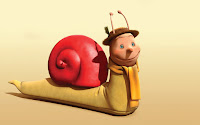I. Becoming All the Animals in Turn.
Sick and tired of well-domesticated modern men like her husband, the female protagonist of Lawrence's short novel St. Mawr (1925), ponders if there mayn't be something else to marvel at in men besides "'mind and cleverness, or niceness or cleanness'" and that perhaps this something else is animality.
Her mother, however, is unconvinced by this idea and imagines that her daughter secretly desires a caveman to club her over the head and carry her away. Angered that her suggestion has been misinterpreted as a vulgar rape fantasy, Lou responds:
"'Don't be silly, mother. That's much more your subconscious line, you admirer of Mind! I don't consider the caveman is a real human animal at all. He's a brute, a degenerate. A pure animal man would be as lovely as a deer or a leopard, burning like a flame fed straight from underneath. [...] He'd be all the animals in turn, instead of one, fixed automatic thing, which he is now, grinding on the nerves."
Mrs. Witt, unnerved by this, argues that whatever else such a combination of man and beast would be, he'd certainly be dangerous. Lou, angry now with her mother, replies that be that as it may, she'd still rather live in a world of animal-men that one full of tame and humble half-men who are merely sentimental and spiteful.
II. Not to Be a Man Anymore
Of course, D. H. Lawrence isn't the only writer to dream of man's becoming-animal, or, indeed, becoming-plant. So too does the French-Romanian philosopher E. M. Cioran. In his first book, for example, published just ten years after Lawrence's St. Mawr, he writes these rather lovely lines:
"I am not proud to be a man, because I know only too well what it is to be a man. [...] If I could, I would choose every day another form, plant or animal, I would be all the flowers one by one: weed, thistle or rose [...] Let me live the life of every species , wildly and un-self-consciously, let me try out the entire spectrum of nature, let me change gracefully, discreetly, as if it were the most natural procedure."
But it's important to note that Cioran isn't looking to escape from or abandon his humanity once and for all, so much as to make it seem a newly attractive option once more:
"Only a cosmic adventure of this kind, a series of metamorphoses in the plant and animal realms, would reawaken in me the desire to become Man again."
See: D. H. Lawrence, 'St. Mawr', in St. Mawr and Other Stories, ed. Brian Finney, (Cambridge University Press, 1983), pp. 59-62, and E. M. Cioran, On the Heights of Despair, trans. Ilinca Zarifopol-Johnston, (The University of Chicago Press, 1992), pp. 68-69.
Note: Helmo is a French design studio established by Thomas Couderc and Clément Vauchez. In the Bêtes de Mode project, they collaborated with Thomas Dimetto to produce a series of double-exposure photographs of man and beast, exhibited at the Galeries Lafayette, Paris, (2006). To see more of these images, click here.
Readers interested in a sister post to this one on DHL and EMC and the question of becoming-ash, should click here.
Readers interested in a sister post to this one on DHL and EMC and the question of becoming-ash, should click here.

























